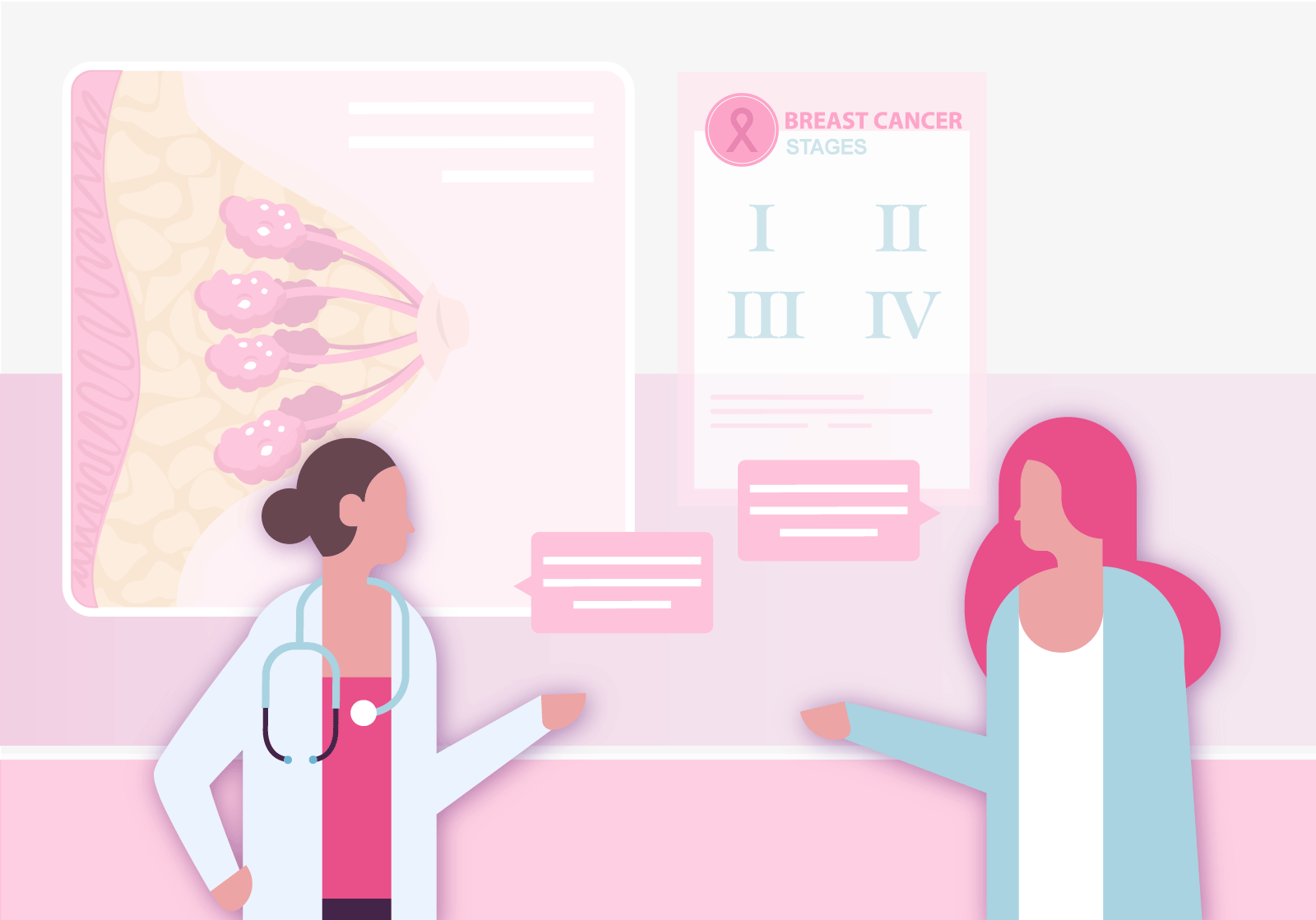Cancer can be divided into a total of five stages (0 to 4). Often labelled with the Roman numerals I, II, III, or IV, the higher the stage the more advanced the cancer is. These stages are determined based on 4 different characteristics determined by the doctor:
· Is the cancer invasive or non-invasive?
· Tumour (T): How large is the tumour?
· Node (N): Has the tumour spread to the lymph nodes?
· Metastasis (M): Has the cancer spread to nearby tissue or organs?
Answering these questions and determining the stage of breast cancer allows You and your doctor to figure out a prognosis, likely outcome of the disease and decide on the best treatment option. The most common stages that breast cancer is found at are stages I and II - in 2017 in Latvia accordingly 31% and 37% of the time (3). The more progressive the growth of the tumour is and the more tissue it invades, the harder it is to control the spread and minimize the risk of related complications.
Stage 0
Stage 0 is used to describe non-invasive breast cancers, such as DCIS (ductal carcinoma in situ). At this earliest stage the cancer cells found in DCIS remain confined to the part of the breast in which they started and there is no evidence of them invading neighbouring normal tissue. Despite difficulty in diagnosing cancer at such an early stage of development, tumours in stage 0 are most commonly found during mammogram screenings. In cases where after a screening there is suspicion over a possibility of a DCIS, your doctor may call for an additional biopsy or ultrasound to confirm the results.
Stage I
In stage I the cancer is considered to be in early development however it has become invasive, which means that cancer cells are breaking through to invade healthy nearby tissue. If the breast cancer is discovered at this stage, there is approximately a 90% chance for complete recovery. Stage I can further be divided into:
Stage 1A: The primary tumour is small about 2 centimetres wide or less and the lymph nodes are not affected.
Stage 1B: The cancer cells have spread to the nearby lymph nodes, and either there is no tumour in the breast, or the tumour is smaller than 2 cm.
Stage II
Stage II breast cancer is still regarded as an early stage of cancer. The majority of women diagnosed at this stage after completing the necessary treatment go on to continue living a satisfactory and fulfilled life. Stage II of breast cancer can be divided into two groups:
Stage 2A: The tumour is smaller than 2 cm and has spread to 1-3 nearby lymph nodes, or it is between 2 and 5 cm and hasn’t spread to any lymph nodes.
Stage 2B: The tumour is between 2 and 5 cm and has spread to 1-3 lymph nodes located in the armpit, or it is larger than 5 cm and hasn’t spread to any lymph nodes.
Stage III
Stage III is an advanced stage of the disease, which signifies that the cancer has spread to neighbouring lymph nodes and muscle tissue. Currently there are numerous effective treatment methods, for example chemotherapy and targeted therapy, that allows to fight cancerous tumours at this stage. Stage III of breast cancer can be divided into three groups:
Stage 3A:
- The cancer has spread to 4–9 axillary lymph nodes or has enlarged the internal mammary lymph nodes, and the primary tumor can be any size.
- Tumors are greater than 5 cm and the cancer has spread to 1–3 axillary lymph nodes or any breastbone nodes.
Stage 3B: A tumor has invaded the chest wall or skin and may or may not have invaded up to 9 lymph nodes.
Stage 3C: Cancer is found in 10 or more axillary lymph nodes, lymph nodes near the collarbone, or internal mammary nodes.
Stage IV
Stage IV breast cancer can be described as metastatic. Diagnosis at this late stage means that the tumour has spread to other organs, such as the bones, lungs, brain, liver, distant lymph nodes or chest wall. Cancer diagnosis at this stage is quite rare, approximately 6 % of the time (4).
The staging process of breast cancer is a very important part of the journey of the disease as it determines how much cancer there is in the body and where it is when diagnosed. Latest evidence shows that the 5-year survival rate for breast cancer diagnosis at stage 0 or I is 91% and 84% for stage II providing a hopeful outlook (1). A late-stage diagnosis is a lot to process requiring extensive communication with your doctor and family.
- Breast Cancer, Five-Year Relative Survival by Stage, Women (Aged 15-99 Years), Former Anglia Cancer Network
- WHO data and Statistics
- Ministru kabineta 2017. gada 31. maija rīkojums Nr. 269 "Par Veselības aprūpes pakalpojumu onkoloģijas jomā uzlabošanas plānu 2017.–2020. gadam". https://likumi.lv/ta/id/291187
- Akram, Muhammad et al., 2017. Awareness and current knowledge of breast cancer. Biological research, 50(1), p.33.
